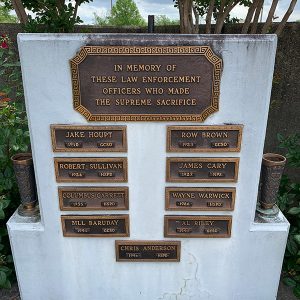calsfoundation@cals.org
James Alexander Cary (1895–1927)
James Alexander Cary, a park policeman at Hot Springs National Park from 1923 to 1927, was the first employee of the National Park Service to be murdered in the line of duty. His body was found on March 12, 1927, in Hot Springs National Park within a few feet of the spot where he had arrested men transporting illegal whiskey across federal property three months before. The case remains officially unsolved.
James Cary was born on December 19, 1895, in Osage, Missouri, to Lillie D. Cary and James B. Cary. He grew up on a family farm in Osage as the third of five children. On June 1, 1917, Cary joined the U.S. Navy and served until February 4, 1919. In 1919, Cary moved to Hot Springs (Garland County), where he worked as a mail clerk in the post office. On December 19, 1920, he married Thelma B. McClaslin (1903–1976); they had two children: James Orvis (1922–2018) and Leora Mae (1926–2006). In 1921, Cary was hired as a clerk with the Army and Navy Hospital in Hot Springs. On October 5, 1923, he was hired as a park policeman in Hot Springs National Park.
On December 7, 1926, Cary arrested Raymond Hunt, Walter Weldon, and Ed Halsey for illegally transporting whiskey through Hot Springs National Park. The trial was scheduled for April 4, 1927, and Cary would be the only witness. On March 12, 1927, at about 4:00 p.m., Cary left park headquarters to conduct a routine patrol of the park. When Cary did not return by 8:00 p.m., park superintendent Joseph Bolton ordered a search. Cary’s body was found early the next morning about fifty feet from where he had arrested the bootleggers several months before. A coroner’s inquest determined that Cary was killed by a .45 caliber pistol bullet fired from close range and that he had been dead since approximately 5:00 p.m. Cary was buried in the Lowe Cemetery in nearby Royal (Garland County) on March 15, 1927.
The investigation into Cary’s murder hit a stone wall due to jurisdictional disputes, the reluctance of many locals to aid an investigation into local criminals, and the possible interference of corrupt officials. In January 1928, James Cary’s widow, Thelma Cary, convinced federal law enforcement to intervene. Federal Bureau of Investigation (FBI) agent J. K. Wren investigated the crime and concluded that local bootleggers Raymond Hunt, Walter Weldon, Ed Halsey, Lawrence Wilson, Roy Wilson, and Dave Camp conspired to murder Cary and that Hunt had probably fired the fatal shot. The defendants were charged with first-degree murder in state court. During the trial, the defense successfully argued that the prosecution witnesses were unreliable and that the defendants had alibis for the time of the murder. The U.S. Attorney’s Office considered federal charges against the defendants but dropped the charges when it determined that the defendants would probably obtain an acquittal in federal court using the same arguments they had used in state court. Raymond Hunt eventually pleaded no contest to violating the prohibition laws and spent one year and a day in federal prison. The federal government dropped all charges against the other defendants.
In 2016, Hot Springs National Park unveiled a monument memorializing James Cary.
For additional information:
Cockrell, Ron. The Hot Springs of Arkansas, America’s First National Park: The Administrative History of Hot Springs National Park. 2014. Online at https://www.nps.gov/hosp/learn/historyculture/research.htm (accessed February 21, 2020).
Heard, Kenneth. “Hot Springs Honors Slain Park Ranger.” Arkansas Democrat-Gazette, May 30, 2016, pp. 1A–2A.
Hill, Mary Bell. Hot Springs National Park. Charleston, SC: Arcadia Publishing, 2014.
“James A. Cary.” Hot Springs National Park. https://www.nps.gov/hosp/learn/historyculture/james-a-cary.htm (accessed February 21, 2020).
Ohlfs, Jeff. “Cary’s Story.” The Record, 1993, 65–69.
Christopher Thrasher
National Park College
 Early Twentieth Century, 1901 through 1940
Early Twentieth Century, 1901 through 1940 Law
Law James Alexander Cary
James Alexander Cary  Sheriff's Memorial
Sheriff's Memorial 



Comments
No comments on this entry yet.